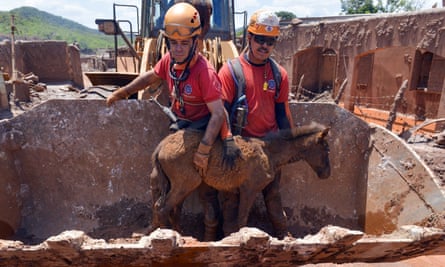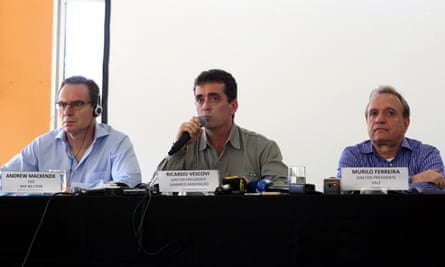Nine people are now confirmed dead, and a further 19 remain unaccounted for as a slow-motion environmental catastrophe continues to unfold following the collapse of two mining dams in Brazil’s mineral-rich state of Minas Gerais.
Eight days after the town of Bento Rodrigues was swept away by 50m cubic metres of toxic mud, a slow-moving tide of toxic iron-ore residue is oozing downriver, polluting the water supply of hundreds of thousands of residents as it makes its way to the ocean.
Brazil’s national water agency, ANA, has warned that the presence of arsenic, zinc, copper and mercury now present in the Rio Doce make the water untreatable for human consumption. Already the lack of oxygen and high temperatures caused by the pollutants has killed off much of the aquatic life along a 500km stretch of the river.
“It is a tragedy of enormous proportions,” Marilene Ramos, president of Ibama, the federal environmental agency, said. “We have thousands of hectares of protected areas destroyed and the total extinction of all the biodiversity along this stretch of the river.”
The mine and dams are operated by Samarco Mineração SA, a joint venture between the Anglo-Australian mining group BHP Billiton, the world’s biggest mining company, and the Brazilian iron ore giant Vale. Shares in BHP Billiton, a FTSE-100 company and therefore a key holding of pension funds around the world – have been battered. Some £8bn has been wiped off the value of the company as its shares in the UK and Australia have slumped by an average of 14%.
For the company – which operates around the world extracting and marketing a range of products from oil, gas, coal and iron ore to copper, silver and uranium – the dam burst comes as mining firms are under pressure. Commodity prices are at a multi-year lows as a result of slowing demand from China. BHP Billiton’s UK shares, which closed at 883p last night, were changing hands at almost £20 only 16 months ago.

On Thursday, Ibama announced a preliminary fine of 250m reals (US$66m) for Samarco, but the final cost – the financial and reputational damage – will be much, much higher.
Ramos stressed that the fine did not include the cost of the clean-up operation, lawsuits and compensation payments. The Brazilian financial magazine Exame, quoting an anonymous government source, said the total cost was likely to run to between R$5bn-R$10bn (US$1.3bn-US$2.6bn).
There will also be operational losses: the Minas Gerais mine produced more than 5% of BHP Billiton’s iron ore output and about 3% of the group’s earnings. Now Samarco has also been stripped of its mining licence.
BHP Billiton was formed in 2001, when Australia’s Broken Hill Proprietary merged with South Africa’s Billiton. By Thursday the firm, and its partner Vale, had sent senior management to see the damage caused and promised an emergency fund expected to be around $100m. But already there are allegations that there had been warnings about the design of the dam and its safety.
Asked whether she still had confidence in Brazilian mining regulations, Ramos said she believed safety measures needed to be revised in the wake of this disaster. “It cannot be right that in the last 12 years we have had five accidents in the state of Minas Gerais alone,” she said.
Early next week the mudslide is expected to reach the Atlantic, with a potentially devastating impact on the fishing communities along the coast of the state of Espírito Santo.
On a visit to the affected region on Thursday, President Dilma Rousseff described the incident as “possibly the biggest environmental disaster to have impacted one of the major regions of our country”.

She compared the scale of the damage to the Deepwater Horizon disaster in the Gulf of Mexico, and laid the blame squarely on Samarco.
“We are committed in the first place to finding those who are responsible,” Rousseff said. “Who is responsible? A private business, Samarco – a big business that has Vale and BHP Billiton as partners.”
Also on Thursday, Brazil’s deputy attorney-general, Sandra Cureau, argued that the companies should be subject to “exemplary punishment” given their “negligence” over the accident.
“Vale and BHP were totally careless in preventing this,” she said. “They did not show a plan of action in case of disaster. They had no alarm system in place.”

At a press conference on Wednesday, the chief executives of BHP Billiton, Andrew Mackenzie, and Vale, Murilo Ferreira, offered apologies for the disaster and insisted they would honour their obligations as joint owners.
However, they offered no comments to reports that Vale had diverted extra water from another mine to the tailings pond behind the dam in the weeks preceding its collapse.
The government itself has come under criticism for the sluggish nature of its response. Critics point out it took Rousseff a whole week to visit the region, while the conservative daily Folha de São Paulo pointed out that the state body responsible for monitoring the country’s dams, the DNPM, checked each of them only once every four years.
Despite the importance of mining to the Brazilian economy, the DNPM only has 220 inspectors charged with monitoring 27,293 sites nationwide. Last year, three workers were killed at a dam near the area of last week’s accident.
In 2012, thousands of residents of the town of Campo dos Goytacazes were forced to flee their homes as water starting leaking through a dam. Another breakage at a dam in the north-eastern state of Piauí in 2009 resulted in the deaths of 24 people.
Maurico Guetta, a lawyer for the environmental NGO Instituto Socioambiental, described the close links between the government and the mining industry in a blog post for the organisation: “Could it be that this tragedy would bring any lessons for our governors and legislators? Unfortunately, there seems to be no sign of that,” he wrote.
Vale was one of the major corporate donors to both Rousseff and the main opposition candidate, Aécio Neves, in last year’s presidential elections. Fernando Pimentel, the governor of the state of Minas Gerais and another beneficiary of Vale campaign donations, held his first press conference in the wake of the tragedy at the headquarters of Samarco.

At present congress is debating a law that would diminish environmental regulation for “strategic infrastructure projects in the national interest”, including mining.
Meanwhile, in Governador Valadares, a town of 200,000 people some 330km from the site of the original accident, the local authorities are bringing in emergency water supplies for hospitals and schools from up to 100km away.
For other residents, the stockpiles of drinking water are running low. “The town’s three universities have closed and all the students have all gone home,” said Nagel Madeiros, from the city government. “Many people are leaving.”

Comments (…)
Sign in or create your Guardian account to join the discussion